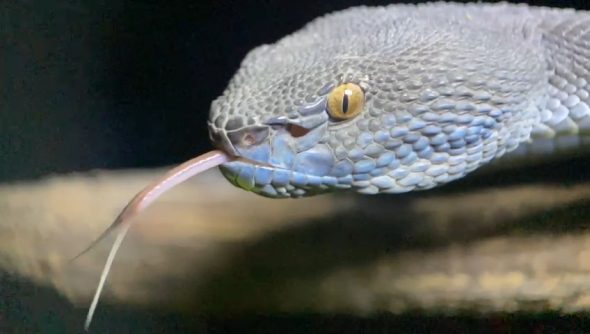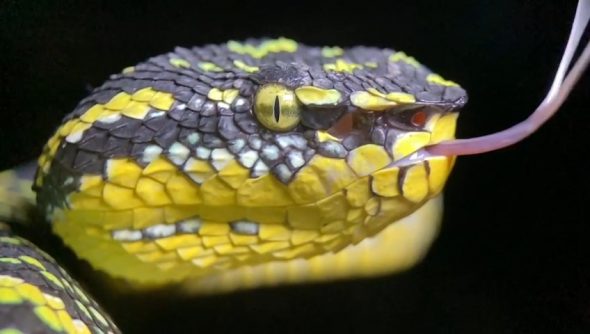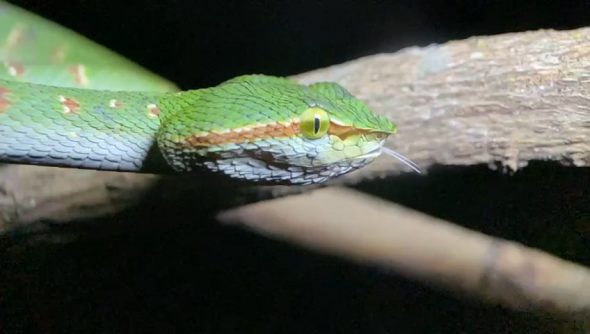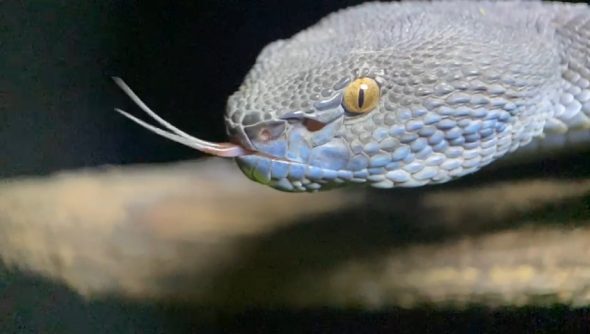Pit Vipers

Vipers
Viperidae (Vipers) is a large family of venomous snakes found all over the world except snake free places like Antarctica, Ireland, Greenland, Hawaii, Madagascar and New Zealand. Australia has snakes but no vipers.
There are more than 3,900 species of snakes grouped into 520 genera and 20 families. The family of vipers (Viperidae) has at least three sub-families. One of these sub-families is Crotalinae (pit viper), containing 22 genera and 151 species.
All vipers have a pair of long hollow (solenoglyphous) front fangs that are rotatable. Each front fang arises from its own small piece of maxillary bone that is freely rotatable forward and backward. At rest, the long fangs are rotated to point backwards and rest against the roof of the mouth, safely enclosed in its own membranous sheath. During an attack, its jaws can be opened wide, as much as 180o. Its front fangs are rotated forward and outward. Fangs can be moved independently of each other. The front portion of its body can be speared forward like the release of a coiled spring. All these constitute a stabbing attack. On contact, compressor muscles around the venom gland constrict and force the stored venom out at high pressure, via the connecting duct and hollow fang, into the prey’s body.
The venom gland is actually an enlarged, modified parotid gland (salivary gland), situated at the back of the head, behind the eye. This could possibly result in the classical description of a viper’s head being triangular and larger than its neck. Maybe like a human with mumps? Venom is actually modified saliva, containing a complex mixture of digestive and toxic proteins.
Venom from vipers mainly attacks the cardiovascular system (haemotoxin). It causes damage to the endothelium of blood vessels, lysis of red blood cells and clotting defects. It damages the skeletal muscles (myotoxin) and heart muscle (cardiotoxin). Death is usually from cardiovascular collapse.
Venom from elapids (e.g. Cobras from Family Elapidae) is usually neurotoxic in contrast. Death is usually from asphyxia due to paralysis of diaphragm and respiratory muscles.
However, in practice there is usually a mixture of haemotoxic and neurotoxic effects.
Venom also contains hyaluronidase. This breaks down hyaluronan in the extra-cellular matrix, making it less viscous, so that the venom can spread more easily.
Some snake bites are called dry bites because no venom is injected. Snake has the ability to control the amount of venom they inject.
Snakes can also bite and release. They let the prey escape so as not to be injured by the prey’s retaliatory actions. The snakes then track down the dying prey by means of tracking chemicals (disintegrins) that are released into the air from the bitten site. Disintegrins belong to a family of small proteins (45 to 84 amino acids in length) found in the venom of vipers. They prevent platelet aggregation and destroy cell to cell adhesion. By means of their forked tongue, vipers are able to follow this Disintegrin trail in the air, back to their escaped prey. Their tongues pick up this air-borne, non-volatile chemical and convey it to a paired sensory organ (Jacobson’s organ) in the roof of their mouth. This pair of organs is able to confirm the chemical and assess its concentration. By comparing the concentration difference between the left and the right fork of the tongue the viper can accurately track its prey. Jacobson’s organs are also found in about 20% of human adult, but so far are deemed to be non-functional (vestigial structure).
Vipers, like all snakes have no external ears but have internal ears. The underside of a viper is capable of detecting minute earth-borne vibrations. The lower jaw is actually made up of two separate halves joined together anteriorly by an elastic ligament. Posteriorly, it is joined loosely to the elongated quadrate bones. Thus, when the head is laid on the ground, it is capable of picking up stereo sound vibrations from the ground. All these help it to accurately pin-point a moving prey 300 feet away.
The jaw bones are not the only bones loosely connected. Many of the skull bones except for the solid neurocranium are also loosely connected. This phenomenon is known as Cranial Kinesis. This allows snakes to swallow prey that are larger in diameter than its head.
First Aid for snake bites
The first reaction to snake bites is fear. Fear of death or permanent damage like lost of limbs. This will cause increase in heart beat which lead to a quickened blood circulation which leads to a faster spread of venom. Hence, reassurance to bite victim is necessary. About 50% of venomous snake bites are of the dry type, that means no or little venom is injected. Next, the affected limb must be immobilized. This is to stop the muscles in the limb from contracting and pumping the venom into the circulation. Previously, tourniquets were advocated for use but in non-medical hands it can lead to amputation of limbs. Nowadays, compressive whole limb bandaging is used. This is to compress the lymphatic system so that the venom does not spread through lymphatic drainage. The elastic bandage must not be so tight as to stop blood flow through the limb. Other treatments like suction of venom out through the bite wound, trimming of bitten wounds, heat cautery of wound have proven to be ineffective. Bite victim is to be brought to hospital as soon as possible. Any cleaning cloth in contact with venom must be kept, in case the hospital has facilities to check for types of toxins involved.
Tropidolaemus wagleri
They are also known as Wagler’s pit viper, palm pit viper, temple pit viper.




Video 1 taken in Mandai Track 15, Singapore on 14 June 2021. Tropidolaemus wagleri
Video 2 taken in Mandai Track 15, Singapore on 14 June 2021. Tropidolaemus wagleri
It is known as temple pit viper because many of these vipers are displayed in the famous Snake Temple of Penang, Malaysia. Officially, it is called the Temple of the Azure Cloud and is dedicated to Chor Soo Kong, a Buddhist monk who lived in China from 960 – 1279. Legend relates to Wagler’s pit vipers appearing at the temple when it was completed in the 1800s. Wagler’s pit vipers tend to be docile in nature. Click on this LINK, to find out more about the Penang Snake Temple.
The unique feature of Pit Vipers is the presence of a heat sensing pit situated between the eye and its nostrils, one on each side of the head. This Infrared detector is so sensitive that it can detect a prey that is just 0.020C hotter than the background. It also has thermal rangefinder capability. Since most pit vipers are nocturnal hunters this sixth sense greatly increases their chances of catching a prey. This thermal detector is also useful in avoiding predators and in seeking out a cool place to rest during hot day times.
Wagler’s pit viper has a golden eye with a vertical slit pupil, which is common in nocturnal creatures. With little light at night, the pupils are open up, so that vipers can see well. It is only in the daytime that their pupils constrict to become a vertical slit. This is to protect their sensitive retinal layer from the excessive day time light. It is found that a vertical slit is more effective than a small round pupil in cutting down excessive light. A vertical slit, combined with side to side movement of the head, also gives a wider and better field of view than a small pin hole. And since all snakes have no eye lids, they sleep with their eyes open. Their eyes are continuously exposed to strong daylight. That is why, it is especially important for them to have the most energy-efficient way of constricting their pupils.
Wagler’s pit viper is one of six species in the genera. It is sexually dimorphic.
Adult females can grow up to 3.5 feet. Dorsally they usually have a black or brownish base with yellow or orange cross bands. Many yellow dots are seen laterally near the banded pale underside. Top of head is usually blackish, with thick black eye stripe on each side of the head.
Adult males are smaller, growing to 2.5 feet. They are uniformly lime green color with widely separated white spots along the lateral side of its body length. It has a bicolored eye stripe. The white stripe is thinner than the red stripe below. Its lips and undersides of head are white in color.
Juvenile females are lime green with bicolored (white and red) cross bands.
Walger’s pit viper has keeled scales. There is a raised central ridge on each of the scales. Their function is unknown. It is suggested that this feature may help in reducing reflection of light from their body. Some snakes use it to create warning sounds, by rubbing certain body parts together. This is known as stridulation, which is common amongst insects like cicadas.
They are arboreal ambush predators with prehensile tail. Their diet consists of rodents, birds and lizards. They strictly carnivorous.
They give birth to live young. This is actually retention of eggs for an extended period of time inside the mother. The snake babies are each enclosed with its own yolk sac within a membrane. There is no direct nourishment from the mother. The eggs hatch inside and emerge free living. This is known as Ovoviviparous. Litter size varies from 15 to 41.
These vipers are found in South Vietnam, South Thailand, South Philippines, Malaysia, Singapore, Indonesia and the Island of Borneo. In Singapore, they are found in Bukit Timah Reserve, Central Catchment Reserve and Pulau Tekong.
Cryptelytrops purpureomaculatus (previously known as Trimeresurus purpureomaculatus )
Also known as Mangrove pit viper and Shore pit viper.

Video 3 taken in Pasir Ris Park, Singapore on 15 June 2021, 10.30pm Cryptelytrops purpureomaculatus
Video 4 taken in Pasir Ris Park, Singapore on 15 June 2021 Cryptelytrops purpureomaculatus using its forked tongue to sense its surroundings.
They are found in India, Bangladesh and South East Asia. In Singapore, they are found in Sungei Buloh Wetland Reserve and Pasir Ris Nature area. They are rarely seen and their status is Endangered.
Females can grow to 3 feet and males to 2 feet.
Their body color can be quite variable, from olive, grey to dark purplish brown on dorsal aspect and whitish, greenish or brown on ventral side. They have a prehensile tail. Their large red eyes give them an angry look. They tend to attack with little provocation. This temperament is in contrast to that of the Wagler’s pit viper.
Article by Wong Kais
Videos courtesy of Mr. Samuel Seow An
Photos are extracted from above videos.
References:
1) https://en.wikipedia.org/wiki/Snake
2) https://singapore.biodiversity.online/taxo4254/mainSpace/Cryptelytrops%20purpureomaculatus.html
3) https://en.wikipedia.org/wiki/Snakebite
4) https://en.wikipedia.org/wiki/Pit_viper
5) https://en.wikipedia.org/wiki/Viperidae#cite_note-ITIS-2
6) https://en.wikipedia.org/wiki/Disintegrin







